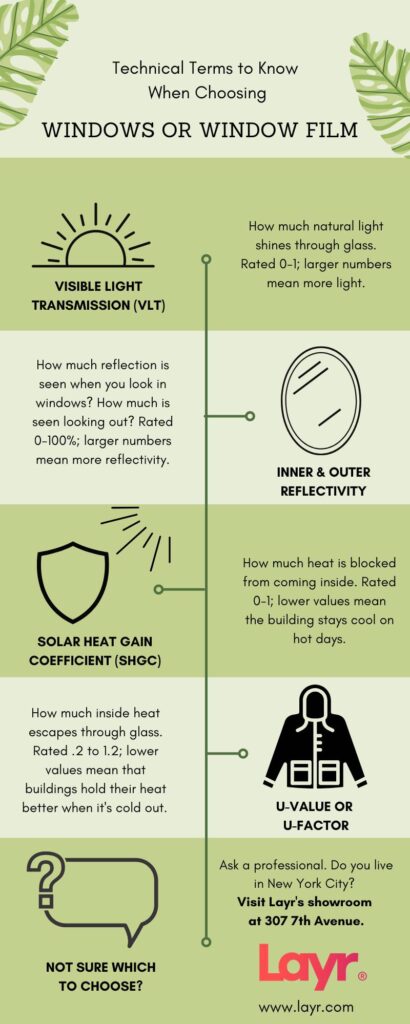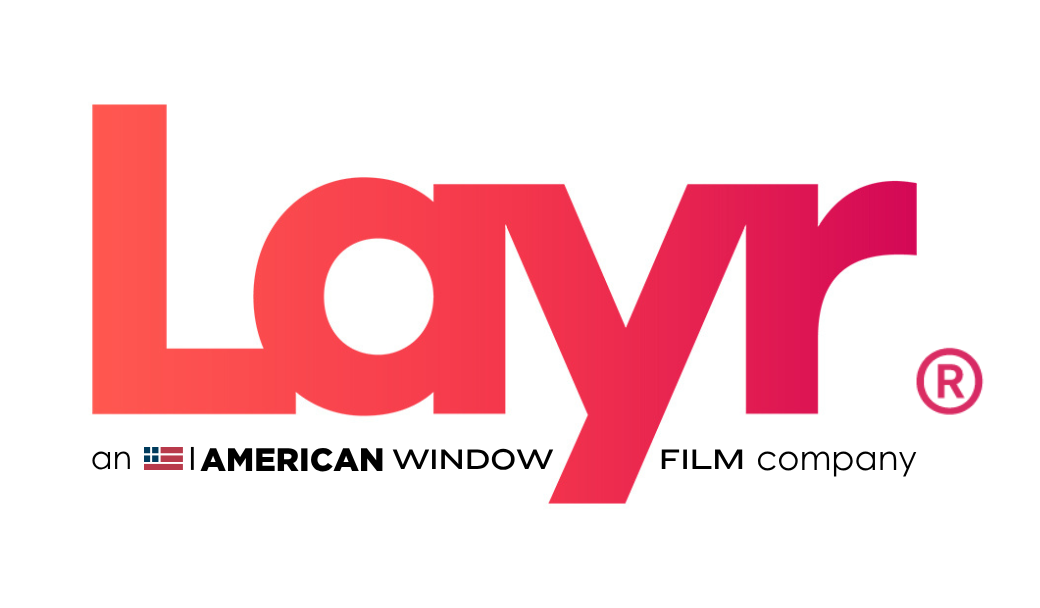These five terms will help you determine the right windows or window film to lower bills and keep buildings energy efficient.
You’ve probably heard it’s a good idea to upgrade your old windows by installing film or to simply use energy efficient window film in the first place. Upgrading your windows comes with many benefits. You’ll protect furniture from sun damage, keep your building warm in the winter and cool in the summer, limit the use of fossil fuels, and save money that would otherwise be spent on utilities.
But, start looking, and you might have some questions:
- What are the most important aspects to consider in window film?
- How are each of these metrics scored?
- How do I consider all of these metrics at the same time to make the best choice for my building?
- How do I make sense of the technical jargon?
We’ve got you covered. Take a look at the infographic below and read on to understand the words you need to know when choosing energy-efficient windows or window film.

1. Visible light transmission (VLT)
The first element to consider relates to light, or visible light transmission (VLT). The higher the number, the brighter your building is on sunny days. VLT is rated with a number from 0 to 1.
Windows with a VLT closer to 0 are darkly tinted and have nearly blacked-out windows. Windows with a VLT closer to 1 mean rooms with lots of natural light. Using extreme examples, a building with a hole in the envelope would have a VLT of 1.0. Most typical, single or double paned glazing has VLTs of 0.7 to 0.90.
One of the many benefits to modern window films is how natural light gets through but the heat doesn’t. We usually recommend glass with a VLT between .5 to .7. This ensures the room isn’t too dark but also doesn’t have glare when there’s sunshine.
2 & 3. Interior and exterior reflectivity
The next metrics you will notice on your window film are its reflectivity. Reflectivity is the difference between looking into a mirror and looking through a clear pane of glass. All glass has a some level of reflectivity on the outside and the inside. When you browse window film, you will see percentages for both interior and exterior reflectivity.
People usually want a clear view of the world outside their windows. On the other hand, reflective glass lessens solar heat gain and can create some pretty incredible building aesthetics, namely daytime privacy. When you are thinking through reflectivity, what you choose will depend on your design and the functionality you want.

Understand VLT and reflectivity? Great. Let’s move on to the two defining energy efficiency metrics for any window or window film; solar heat gain coefficient and U-Value.
4. Solar heat gain coefficient (SHGC)
The solar heat gain coefficient represents the amount of heat being blocked from coming through the windows. SHGC is an important metric for solar efficiency. The lower a SHGC, the better it will keep out heat and the lower your cooling costs will be. The SHGC is actually the inverse of a related term, Total Solar Energy Rejected. For example, a very dark window film on single-paned 1/4″ glass may have a SHGC of 0.28, this means 72% of the total solar energy is being rejected.
On the other hand, higher SHGCs mean that a window is letting in a lot of exterior heat, and related HVAC systems may have trouble cooling. A SHGC of 0.8 or 1.0 implies very inefficient windows, and an opportunity to improve.
Sometimes, in the winter, you want that free natural heat the sun provides. The trick is getting that just-right balance of outside heat that doesn’t turn uncomfortable in hot weather. Every building is different, but generally architects and contractors choose window film with an SHGC that’s <0.40.
5. U-Value
The final metric in choosing energy efficient windows is the U-Value, also called the U-Factor when applied to the entire window assembly (framing / etc.). This is a number between 0.2 and 1.20 that represents how much convective heat escapes the building. The lower the U-value, the better the building is at holding heat in. In a New York City winter, having a low U-value means a cozy building with lower heating bills, even as snow piles up outside.
While the SHGC represents the air blocked from coming in (imagine a shield deflecting energy), the U-Value represents air blocked from going out (think of a thermal jacket in cold weather). Both of these values are a strong measure towards making an energy-efficient building. We see an increasing emphasis on winter insulation, and lower U values, especially with the adoption of carbon-focused initiatives like New York City’s Local Law 97.
Many clients choose products with U-Values around 0.40, though every project and window is different. Window film choices are best made holistically with an eye towards the needs of the building and the people who will be using it.
Conclusion
When you are choosing windows or window film, start with thinking about your needs:
- How do you want it to look?
- What are the pre-existing issues? Does the building get too hot, too cold, too much glare, are you in need of daytime privacy?
- How do you want it to function?
- How do you want it to perform in various types of weather?
Once you’ve decided on these factors, you’re ready to start looking at various products and match them with your needs. Now that you know the terms used to score different window films, you’ll be able to choose something that’s right for you. If you are looking for a specialty 3M product to provide extra security, branding, or to meet local building requirements, all the terms here still apply.
If you are in New York, you can visit our showroom and get a hands-on demonstration. Or you can message us for more information.
